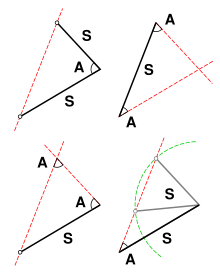정의
등거리 변환은 두 점 사이의 거리를 보존하는 변환이다.
유클리드 공간 <math xmlns="http://www.w3.org/1998/Math/MathML" alttext="{\displaystyle \mathbb {R} ^{n}}"><semantics><annotation encoding="application/x-tex">{\displaystyle \mathbb {R} ^{n}}</annotation></semantics></math> 의 두 도형 <math xmlns="http://www.w3.org/1998/Math/MathML" alttext="{\displaystyle M,N\subseteq \mathbb {R} ^{n}}"><semantics><annotation encoding="application/x-tex">{\displaystyle M,N\subseteq \mathbb {R} ^{n}}</annotation></semantics></math>
의 두 도형 <math xmlns="http://www.w3.org/1998/Math/MathML" alttext="{\displaystyle M,N\subseteq \mathbb {R} ^{n}}"><semantics><annotation encoding="application/x-tex">{\displaystyle M,N\subseteq \mathbb {R} ^{n}}</annotation></semantics></math> 이 다음 조건을 만족시키면, <math xmlns="http://www.w3.org/1998/Math/MathML" alttext="{\displaystyle M,N}"><semantics><annotation encoding="application/x-tex">{\displaystyle M,N}</annotation></semantics></math>
이 다음 조건을 만족시키면, <math xmlns="http://www.w3.org/1998/Math/MathML" alttext="{\displaystyle M,N}"><semantics><annotation encoding="application/x-tex">{\displaystyle M,N}</annotation></semantics></math> 이 합동이라고 한다.
이 합동이라고 한다.
 의 두 도형 <math xmlns="http://www.w3.org/1998/Math/MathML" alttext="{\displaystyle M,N\subseteq \mathbb {R} ^{n}}"><semantics><annotation encoding="application/x-tex">{\displaystyle M,N\subseteq \mathbb {R} ^{n}}</annotation></semantics></math>
의 두 도형 <math xmlns="http://www.w3.org/1998/Math/MathML" alttext="{\displaystyle M,N\subseteq \mathbb {R} ^{n}}"><semantics><annotation encoding="application/x-tex">{\displaystyle M,N\subseteq \mathbb {R} ^{n}}</annotation></semantics></math> 이 다음 조건을 만족시키면, <math xmlns="http://www.w3.org/1998/Math/MathML" alttext="{\displaystyle M,N}"><semantics><annotation encoding="application/x-tex">{\displaystyle M,N}</annotation></semantics></math>
이 다음 조건을 만족시키면, <math xmlns="http://www.w3.org/1998/Math/MathML" alttext="{\displaystyle M,N}"><semantics><annotation encoding="application/x-tex">{\displaystyle M,N}</annotation></semantics></math> 이 합동이라고 한다.
이 합동이라고 한다.- <math xmlns="http://www.w3.org/1998/Math/MathML" alttext="{\displaystyle N=I(M)}"><semantics><annotation encoding="application/x-tex">{\displaystyle N=I(M)}</annotation></semantics></math>
인 등거리 변환 <math xmlns="http://www.w3.org/1998/Math/MathML" alttext="{\displaystyle I\colon \mathbb {R} ^{n}\to \mathbb {R} ^{n}}"><semantics><annotation encoding="application/x-tex">{\displaystyle I\colon \mathbb {R} ^{n}\to \mathbb {R} ^{n}}</annotation></semantics></math>
이 존재한다.
기하학에서, 합동(合同, 영어: congruence)은 두 도형이 모양과 크기가 같음을 나타내는 관계이다. 즉, 두 도형을 점집합으로 생각할 때, 하나에 어떤 등거리 변환에 대한 상을 취하여 다른 하나를 얻을 수 있다면, 두 도형이 합동이라고 한다. 서로 합동인 도형은 서로 닮음이다. 그러나 그 역은 일반적으로 성립하지 않는다.
성질
삼각형의 합동

평면 삼각형은 합동 조건 SAS, ASA, AAS를 갖지만, 합동 조건 SSA를 갖지 않는다.
두 삼각형이 합동이라면, 이 두 삼각형의 세 쌍의 변(의 길이) 및 세 쌍의 각(의 크기)은 각각 같다. 각 쌍의 변을 대응변(對應邊, 영어: corresponding sides)이라고 하며, 각 쌍의 각을 대응각(對應角, 영어: corresponding angles)이라고 한다.
삼각형 <math xmlns="http://www.w3.org/1998/Math/MathML" alttext="{\displaystyle ABC}"><semantics><annotation encoding="application/x-tex">{\displaystyle ABC}</annotation></semantics></math> 와 삼각형 <math xmlns="http://www.w3.org/1998/Math/MathML" alttext="{\displaystyle DEF}"><semantics><annotation encoding="application/x-tex">{\displaystyle DEF}</annotation></semantics></math>
와 삼각형 <math xmlns="http://www.w3.org/1998/Math/MathML" alttext="{\displaystyle DEF}"><semantics><annotation encoding="application/x-tex">{\displaystyle DEF}</annotation></semantics></math> 의 합동은 기호로 다음과 같이 나타낸다.
의 합동은 기호로 다음과 같이 나타낸다.
 와 삼각형 <math xmlns="http://www.w3.org/1998/Math/MathML" alttext="{\displaystyle DEF}"><semantics><annotation encoding="application/x-tex">{\displaystyle DEF}</annotation></semantics></math>
와 삼각형 <math xmlns="http://www.w3.org/1998/Math/MathML" alttext="{\displaystyle DEF}"><semantics><annotation encoding="application/x-tex">{\displaystyle DEF}</annotation></semantics></math> 의 합동은 기호로 다음과 같이 나타낸다.
의 합동은 기호로 다음과 같이 나타낸다.- <math xmlns="http://www.w3.org/1998/Math/MathML" alttext="{\displaystyle \triangle ABC\cong \triangle DEF}"><semantics><annotation encoding="application/x-tex">{\displaystyle \triangle ABC\cong \triangle DEF}</annotation></semantics></math>
단, 같은 위치의 <math xmlns="http://www.w3.org/1998/Math/MathML" alttext="{\displaystyle A}"><semantics><annotation encoding="application/x-tex">{\displaystyle A}</annotation></semantics></math> 와 <math xmlns="http://www.w3.org/1998/Math/MathML" alttext="{\displaystyle D}"><semantics><annotation encoding="application/x-tex">{\displaystyle D}</annotation></semantics></math>
와 <math xmlns="http://www.w3.org/1998/Math/MathML" alttext="{\displaystyle D}"><semantics><annotation encoding="application/x-tex">{\displaystyle D}</annotation></semantics></math> , <math xmlns="http://www.w3.org/1998/Math/MathML" alttext="{\displaystyle B}"><semantics><annotation encoding="application/x-tex">{\displaystyle B}</annotation></semantics></math>
, <math xmlns="http://www.w3.org/1998/Math/MathML" alttext="{\displaystyle B}"><semantics><annotation encoding="application/x-tex">{\displaystyle B}</annotation></semantics></math> 와 <math xmlns="http://www.w3.org/1998/Math/MathML" alttext="{\displaystyle E}"><semantics><annotation encoding="application/x-tex">{\displaystyle E}</annotation></semantics></math>
와 <math xmlns="http://www.w3.org/1998/Math/MathML" alttext="{\displaystyle E}"><semantics><annotation encoding="application/x-tex">{\displaystyle E}</annotation></semantics></math> , <math xmlns="http://www.w3.org/1998/Math/MathML" alttext="{\displaystyle C}"><semantics><annotation encoding="application/x-tex">{\displaystyle C}</annotation></semantics></math>
, <math xmlns="http://www.w3.org/1998/Math/MathML" alttext="{\displaystyle C}"><semantics><annotation encoding="application/x-tex">{\displaystyle C}</annotation></semantics></math> 와 <math xmlns="http://www.w3.org/1998/Math/MathML" alttext="{\displaystyle F}"><semantics><annotation encoding="application/x-tex">{\displaystyle F}</annotation></semantics></math>
와 <math xmlns="http://www.w3.org/1998/Math/MathML" alttext="{\displaystyle F}"><semantics><annotation encoding="application/x-tex">{\displaystyle F}</annotation></semantics></math> 는 대응점이어야 한다.[1]:5
는 대응점이어야 한다.[1]:5
 와 <math xmlns="http://www.w3.org/1998/Math/MathML" alttext="{\displaystyle D}"><semantics><annotation encoding="application/x-tex">{\displaystyle D}</annotation></semantics></math>
와 <math xmlns="http://www.w3.org/1998/Math/MathML" alttext="{\displaystyle D}"><semantics><annotation encoding="application/x-tex">{\displaystyle D}</annotation></semantics></math> , <math xmlns="http://www.w3.org/1998/Math/MathML" alttext="{\displaystyle B}"><semantics><annotation encoding="application/x-tex">{\displaystyle B}</annotation></semantics></math>
, <math xmlns="http://www.w3.org/1998/Math/MathML" alttext="{\displaystyle B}"><semantics><annotation encoding="application/x-tex">{\displaystyle B}</annotation></semantics></math> 와 <math xmlns="http://www.w3.org/1998/Math/MathML" alttext="{\displaystyle E}"><semantics><annotation encoding="application/x-tex">{\displaystyle E}</annotation></semantics></math>
와 <math xmlns="http://www.w3.org/1998/Math/MathML" alttext="{\displaystyle E}"><semantics><annotation encoding="application/x-tex">{\displaystyle E}</annotation></semantics></math> , <math xmlns="http://www.w3.org/1998/Math/MathML" alttext="{\displaystyle C}"><semantics><annotation encoding="application/x-tex">{\displaystyle C}</annotation></semantics></math>
, <math xmlns="http://www.w3.org/1998/Math/MathML" alttext="{\displaystyle C}"><semantics><annotation encoding="application/x-tex">{\displaystyle C}</annotation></semantics></math> 와 <math xmlns="http://www.w3.org/1998/Math/MathML" alttext="{\displaystyle F}"><semantics><annotation encoding="application/x-tex">{\displaystyle F}</annotation></semantics></math>
와 <math xmlns="http://www.w3.org/1998/Math/MathML" alttext="{\displaystyle F}"><semantics><annotation encoding="application/x-tex">{\displaystyle F}</annotation></semantics></math> 는 대응점이어야 한다.[1]:5
는 대응점이어야 한다.[1]:5
두 삼각형 <math xmlns="http://www.w3.org/1998/Math/MathML" alttext="{\displaystyle ABC,DEF}"><semantics><annotation encoding="application/x-tex">{\displaystyle ABC,DEF}</annotation></semantics></math> 가 합동일 몇 가지 충분 조건은 다음과 같다.
가 합동일 몇 가지 충분 조건은 다음과 같다.
 가 합동일 몇 가지 충분 조건은 다음과 같다.
가 합동일 몇 가지 충분 조건은 다음과 같다.- SSS(변변변): 만약 <math xmlns="http://www.w3.org/1998/Math/MathML" alttext="{\displaystyle AB=DE}"><semantics><annotation encoding="application/x-tex">{\displaystyle AB=DE}</annotation></semantics></math>
, <math xmlns="http://www.w3.org/1998/Math/MathML" alttext="{\displaystyle AC=DF}"><semantics><annotation encoding="application/x-tex">{\displaystyle AC=DF}</annotation></semantics></math>
, <math xmlns="http://www.w3.org/1998/Math/MathML" alttext="{\displaystyle BC=EF}"><semantics><annotation encoding="application/x-tex">{\displaystyle BC=EF}</annotation></semantics></math>
라면, <math xmlns="http://www.w3.org/1998/Math/MathML" alttext="{\displaystyle \triangle ABC\cong \triangle DEF}"><semantics><annotation encoding="application/x-tex">{\displaystyle \triangle ABC\cong \triangle DEF}</annotation></semantics></math>
이다. 즉, 두 삼각형의 세 쌍의 대응변이 각각 같다면, 두 삼각형은 합동이다.
- SAS(변각변): 만약 <math xmlns="http://www.w3.org/1998/Math/MathML" alttext="{\displaystyle AB=DE}"><semantics><annotation encoding="application/x-tex">{\displaystyle AB=DE}</annotation></semantics></math>
, <math xmlns="http://www.w3.org/1998/Math/MathML" alttext="{\displaystyle AC=DF}"><semantics><annotation encoding="application/x-tex">{\displaystyle AC=DF}</annotation></semantics></math>
, <math xmlns="http://www.w3.org/1998/Math/MathML" alttext="{\displaystyle \angle A=\angle D}"><semantics><annotation encoding="application/x-tex">{\displaystyle \angle A=\angle D}</annotation></semantics></math>
라면, <math xmlns="http://www.w3.org/1998/Math/MathML" alttext="{\displaystyle \triangle ABC\cong \triangle DEF}"><semantics><annotation encoding="application/x-tex">{\displaystyle \triangle ABC\cong \triangle DEF}</annotation></semantics></math>
이다. 즉, 두 삼각형의 두 쌍의 대응변 및 그 사잇각이 각각 같다면, 두 삼각형은 합동이다.
- ASA(각변각): 만약 <math xmlns="http://www.w3.org/1998/Math/MathML" alttext="{\displaystyle \angle A=\angle D}"><semantics><annotation encoding="application/x-tex">{\displaystyle \angle A=\angle D}</annotation></semantics></math>
, <math xmlns="http://www.w3.org/1998/Math/MathML" alttext="{\displaystyle \angle B=\angle E}"><semantics><annotation encoding="application/x-tex">{\displaystyle \angle B=\angle E}</annotation></semantics></math>
, <math xmlns="http://www.w3.org/1998/Math/MathML" alttext="{\displaystyle AB=DE}"><semantics><annotation encoding="application/x-tex">{\displaystyle AB=DE}</annotation></semantics></math>
라면, <math xmlns="http://www.w3.org/1998/Math/MathML" alttext="{\displaystyle \triangle ABC\cong \triangle DEF}"><semantics><annotation encoding="application/x-tex">{\displaystyle \triangle ABC\cong \triangle DEF}</annotation></semantics></math>
이다. 즉, 두 삼각형의 두 쌍의 대응각 및 그 공공변이 각각 같다면, 두 삼각형은 합동이다.
- AAS(각각변): 만약 <math xmlns="http://www.w3.org/1998/Math/MathML" alttext="{\displaystyle \angle A=\angle D}"><semantics><annotation encoding="application/x-tex">{\displaystyle \angle A=\angle D}</annotation></semantics></math>
, <math xmlns="http://www.w3.org/1998/Math/MathML" alttext="{\displaystyle \angle B=\angle E}"><semantics><annotation encoding="application/x-tex">{\displaystyle \angle B=\angle E}</annotation></semantics></math>
, <math xmlns="http://www.w3.org/1998/Math/MathML" alttext="{\displaystyle BC=EF}"><semantics><annotation encoding="application/x-tex">{\displaystyle BC=EF}</annotation></semantics></math>
라면, <math xmlns="http://www.w3.org/1998/Math/MathML" alttext="{\displaystyle \triangle ABC\cong \triangle DEF}"><semantics><annotation encoding="application/x-tex">{\displaystyle \triangle ABC\cong \triangle DEF}</annotation></semantics></math>
이다. 즉, 두 삼각형의 두 쌍의 대응각 및 그 공공변이 아닌 변이 각각 같다면, 두 삼각형은 합동이다.
- RHS: 만약 <math xmlns="http://www.w3.org/1998/Math/MathML" alttext="{\displaystyle \angle C=\angle D=90^{\circ }}"><semantics><annotation encoding="application/x-tex">{\displaystyle \angle C=\angle D=90^{\circ }}</annotation></semantics></math>
, <math xmlns="http://www.w3.org/1998/Math/MathML" alttext="{\displaystyle AB=DE}"><semantics><annotation encoding="application/x-tex">{\displaystyle AB=DE}</annotation></semantics></math>
, <math xmlns="http://www.w3.org/1998/Math/MathML" alttext="{\displaystyle AC=DF}"><semantics><annotation encoding="application/x-tex">{\displaystyle AC=DF}</annotation></semantics></math>
라면, <math xmlns="http://www.w3.org/1998/Math/MathML" alttext="{\displaystyle \triangle ABC\cong \triangle DEF}"><semantics><annotation encoding="application/x-tex">{\displaystyle \triangle ABC\cong \triangle DEF}</annotation></semantics></math>
이다. 즉, 두 직각 삼각형의 빗변과 한 직각변이 각각 같다면, 두 직각 삼각형은 합동이다.
그러나, 다음 조건 가운데 하나를 만족시키는 두 삼각형 <math xmlns="http://www.w3.org/1998/Math/MathML" alttext="{\displaystyle ABC,DEF}"><semantics><annotation encoding="application/x-tex">{\displaystyle ABC,DEF}</annotation></semantics></math> 는 합동일 필요가 없다.
는 합동일 필요가 없다.
 는 합동일 필요가 없다.
는 합동일 필요가 없다.- SSA(변변각): 만약 <math xmlns="http://www.w3.org/1998/Math/MathML" alttext="{\displaystyle AB=DE}"><semantics><annotation encoding="application/x-tex">{\displaystyle AB=DE}</annotation></semantics></math>
, <math xmlns="http://www.w3.org/1998/Math/MathML" alttext="{\displaystyle BC=EF}"><semantics><annotation encoding="application/x-tex">{\displaystyle BC=EF}</annotation></semantics></math>
, <math xmlns="http://www.w3.org/1998/Math/MathML" alttext="{\displaystyle \angle C=\angle F}"><semantics><annotation encoding="application/x-tex">{\displaystyle \angle C=\angle F}</annotation></semantics></math>
이더라도, <math xmlns="http://www.w3.org/1998/Math/MathML" alttext="{\displaystyle \triangle ABC\ncong \triangle DEF}"><semantics><annotation encoding="application/x-tex">{\displaystyle \triangle ABC\ncong \triangle DEF}</annotation></semantics></math>
일 수 있다. 즉, 두 쌍의 대응변 및 그 사잇각이 아닌 한 쌍의 각이 같더라도, 두 삼각형은 합동이 아닐 수 있다. 다만, 이 각이 직각일 경우, RHS에 따라 합동이다.
- AAA(각각각): 만약 <math xmlns="http://www.w3.org/1998/Math/MathML" alttext="{\displaystyle \angle A=\angle D}"><semantics><annotation encoding="application/x-tex">{\displaystyle \angle A=\angle D}</annotation></semantics></math>
, <math xmlns="http://www.w3.org/1998/Math/MathML" alttext="{\displaystyle \angle B=\angle E}"><semantics><annotation encoding="application/x-tex">{\displaystyle \angle B=\angle E}</annotation></semantics></math>
, <math xmlns="http://www.w3.org/1998/Math/MathML" alttext="{\displaystyle \angle C=\angle F}"><semantics><annotation encoding="application/x-tex">{\displaystyle \angle C=\angle F}</annotation></semantics></math>
이더라도, <math xmlns="http://www.w3.org/1998/Math/MathML" alttext="{\displaystyle \triangle ABC\ncong \triangle DEF}"><semantics><annotation encoding="application/x-tex">{\displaystyle \triangle ABC\ncong \triangle DEF}</annotation></semantics></math>
일 수 있다. 즉, 세 쌍의 대응각기 같더라도, 두 삼각형은 합동이 아닐 수 있다. 다만 이 경우 두 삼각형은 서로 닮음이다.
- 위키
댓글 없음:
댓글 쓰기